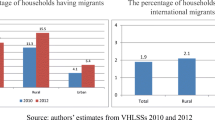Abstract
The impact of migrant workers' remittances on economic activity in their home countries was long overshadowed by the manifestly positive balance of payments effect. Only gradually did it come to be recognized that it was not just the scale of remittances but also the way in which they are used that is of crucial significance for the economies of the migrants' home countries. This article estimates the contribution that such remittances made to GDP, private consumption expenditure, saving and imports in Portugal, Spain, Italy, Greece and Turkey in the period from 1960 to 1981.
Similar content being viewed by others
References
The balance of payments effect of remittances is described at length in T. Straubhaar: Der Zahlungsbilanzeffekt der Devisen transfers ausgewanderter Arbeitskräfte für ihre Herkunftsländer, in: Jahrbücher für Nationalökonomie und Statistik, Vol. 200 (1985) No. 1, and in T. Straubhaar: The significance of Labour Migration for the Workers' Countries of Origin, in: INTERECONOMICS, Vol. 19 (1985), No. 1.
Deutsche Bundesbank: Ausländische Arbeitnehmer in Deutschland: Ihr Geldtransfer in die Heimatländer und ihre Ersparnisse in der Bundesrepublik, in: Monatsberichte, Vol. 26 (1974), No. 4, p. 27.
Kindleberger estimates the marginal propensity to consume at 0.8 (0.5 for food, 0.3 for manufactured consumer, goods) and the marginal propensity to invest at 0.2, without differentiating between domestic and foreign goods (C. P. Kindleberger: Europe's Postwar Growth, Cambridge (Mass.) 1967, p. 97). His assumptions are therefore not far different from our own calculations, which give values of 0.65–0.75 for c, 0.10–0.20 for s and 0.10–0.20 for m. The following quantitative findings with regard to the purpose for which remittances are used are based on empirical studies by the OECD and the ILO in the context of the World Employment Programme and the International Migration for Employment Programme and other studies, whose conclusions are summarised in T. Straubhaar: Arbeitskräfte-wanderung und Zahlungsbilanz, Berne and Stuttgart 1983, pp. 45 ff.
Author information
Authors and Affiliations
Rights and permissions
About this article
Cite this article
Straubhaar, T. Migrants' remittances and economic activity. Intereconomics 20, 87–92 (1985). https://doi.org/10.1007/BF02928459
Issue Date:
DOI: https://doi.org/10.1007/BF02928459




